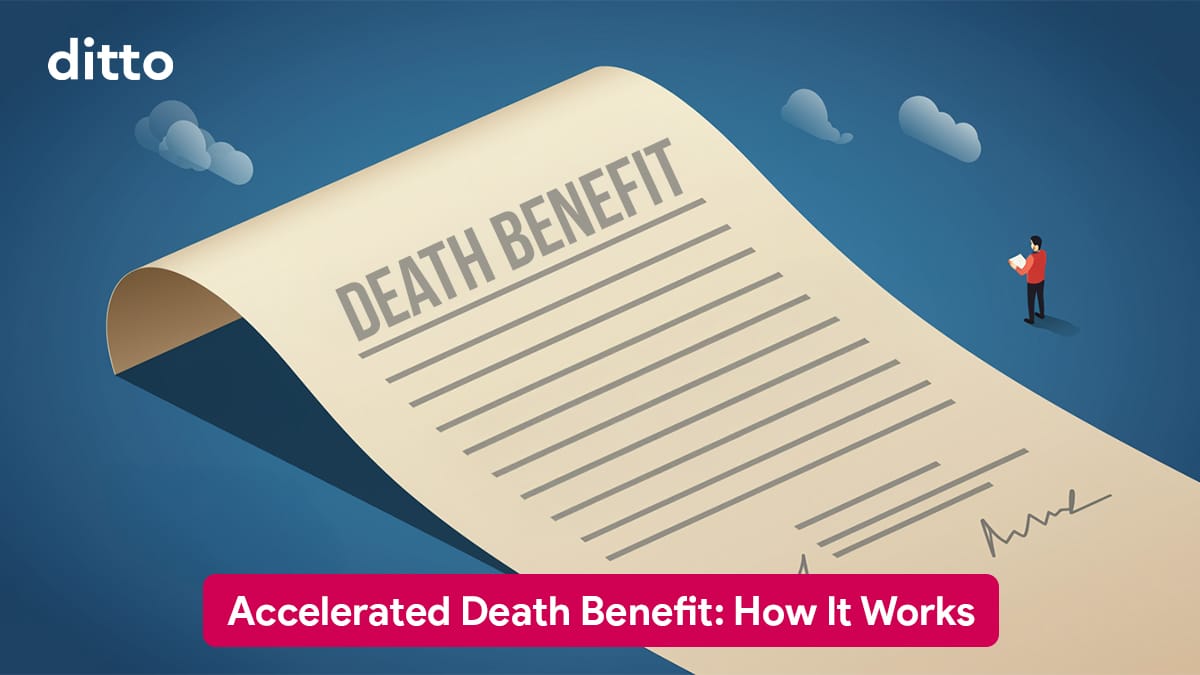An Accelerated Death Benefit (ADB) rider (also called terminal illness benefit/cover) in term insurance promises to pay out a part (or all) of your life cover in advance if you're diagnosed with a terminal illness, typically one expected to lead to death within six months. The idea is simple: give families quick access to funds when they need it most, for treatments, home care, or last-mile expenses.
But here’s the catch: ADB claims are extremely rare. We spoke to a chief underwriter at a leading life insurer who confirmed that such claims are “few and far between,” largely because the conditions to trigger them are so stringent. Doctors are hesitant to put a six-month timeline in writing. And even when they do, insurers require confirmation from independent specialists, giving them plenty of room to delay or deny the claim.
In this article, we’ll break down how ADB really works, why payouts are uncommon, and whether it’s worth paying extra for. If you’re considering adding this rider to your term plan or wondering whether to choose a policy that offers it for free, this guide will help you make that decision with confidence.
| Note: We’ve used the abbreviation ADB throughout this piece to refer to Accelerated Death Benefit, but it should not be confused with the Accidental Death Benefit rider. |
What is an Accelerated Death Benefit and how does it work?
Most term insurance plans pay the full sum assured to your nominee after you pass away. But with an Accelerated Death Benefit (ADB), part of that payout can come to you while you’re still alive, if you’re diagnosed with a terminal illness that’s expected to lead to death within six months.
Here’s what that looks like in practice:
Let’s say a 45-year-old has a ₹2 crore term plan with an ADB rider. They’re diagnosed with stage IV pancreatic cancer, and two doctors confirm that survival beyond six months is unlikely. The insurer reviews the reports, accepts the claim, and pays ₹1 crore upfront by “accelerating” a part of your cover. This money can help cover medical expenses, palliative care, or anything else the family needs during that time.
But it’s not always your full cover. Most insurers cap the accelerated amount at ₹1 crore, even if your total cover is higher. So in this case, the remaining ₹1 crore would be paid to the nominee after death.
In short: ADB can offer financial relief in critical moments, but only under very specific conditions, and often not for the entire sum assured.
What conditions need to be met to trigger the Accelerated Death Benefit
There’s no uniform standard for ADB claims
While Accelerated Death Benefit (ADB) is marketed as a terminal illness payout, the actual conditions to trigger it vary across insurers and these differences often determine whether a claim is accepted, delayed, or denied.
Additionally, please note that insurers typically impose a waiting period of 1-3 years before this benefit can be claimed.
Take ICICI Prudential, HDFC Life, Axis Max Life, and Tata AIA for example:
- ICICI Prudential iProtect Smart Plus offers one of the most comprehensive Accelerated Death Benefit features in the market. It requires a diagnosis that, in the opinion of two independent medical practitioners, is “highly likely to lead to death within six months.” The doctors must be approved by the insurer, and additional verification may be initiated. There’s no cap on the benefit, and 100% of the cover can be accelerated.
- HDFC Life’s Click 2 Protect Supreme offers a built-in Accelerated Terminal Illness Benefit. Under this feature, if the life assured is diagnosed with a terminal illness as defined in the policy, up to ₹2 crore of the base sum assured can be paid out in advance. This early payout can help manage end-of-life expenses or provide financial support to the family when it's needed most.
- Axis Max Life requires the diagnosis to be supported by a registered medical practitioner and approved by the company’s own medical officer. The illness must be “expected to result in death within six months,” and the ADB payout is capped at ₹1 crore, even if the total sum assured is higher.
- Tata AIA Sampoorna Raksha Promise offers an inbuilt accelerated death benefit feature for terminal illness, allowing up to 50% of the base sum assured to be paid out early. Unlike other insurers, there’s no absolute monetary cap on the benefit (like ₹1 crore or ₹2 crore limits), making it more flexible, especially for policies with higher coverage.
As you can see, there’s no single rulebook. Some demand two independent specialists; others rely on their own doctors. Some permit payouts during treatment; others don’t. These subtle variations become major hurdles in real-life scenarios.
During our research, we discovered that there’s no prescribed list of terminal illnesses issued by IRDAI or insurers. This is unlike the Critical Illness rider, where the insurer specifies the number of conditions and the severity at which the CI payout will be triggered.
It’s easy to get lost comparing policies, riders, and premiums. Instead of spending hours on it, why not get personalised insurance advice from Ditto? We offer free consultations with zero spam! Just 30 minutes to clarify all your doubts. Book a free call now!
Is the Accelerated Death Benefit Rider useful?
Our opinion is that triggering Accelerated Death Benefit isn’t easy.
We’re currently helping a family file an ADB claim for a patient undergoing chemotherapy for end-stage cancer. The prognosis is poor, and the family needs funds urgently. But the insurer has asked the treating oncologist to put in writing that the patient is expected to die within six months.
The doctor is understandably hesitant committing to a specific timeline, especially when treatment is ongoing. The insurer has also insisted on getting this independently verified, adding further delays.
We also spoke to a chief underwriter at a leading life insurer, who confirmed that ADB claims are few and far between. While they didn’t disclose the exact number of claims processed each year, they made one thing clear: every claim is investigated thoroughly. The concern, as they put it, is simple: “Once the payout is made, the policy terminates. So if the patient survives beyond six months, there's no recourse.”
This is why insurers demand such rigorous medical proof and layered verification. The bar isn’t just clinical, it’s contractual. And that makes ADB one of the most difficult benefits to actually claim in a term policy.
| Did you know? Many term insurance plans limit the Terminal Illness Benefit if you're over 80 years of age. In some cases, insurers won’t pay anything early if you're diagnosed with a terminal illness after age 80. Under the HDFC Life Click 2 Protect (C2P) Supreme plan, the Terminal Illness Benefit is only available up to the age of 80. If you're diagnosed with a terminal illness after turning 80, you won’t be eligible for an early payout. Even if you're below 80, the maximum amount that can be paid early under this benefit is capped at ₹2 crore, regardless of your total sum assured. |
So, should you buy the Accelerated Death Benefit rider with your term plan?
In most retail term plans, ADB isn’t sold as a separate rider. Insurers either:
Free ADB (as part of the base plan)
- Include it for free in the base plan as HDFC Life,Bajaj Allianz, ICICI Pru and Axis Max Life do
Free ADB Examples:
- ICICI Pru iProtect Smart Plus: Full ADB included by default
- HDFC Life Click 2 Protect Supreme & Bajaj Allianz E-touch II : ADB Included, capped at ₹2 crore
- Axis Max Life Smart Term Plan Plus: ADB included, capped at ₹1 crore These plans give you the benefit without increasing your premium, so there’s no downside in opting for them.
Paid ADB (as part of a bundle):
Some plans charge an additional premium, but they don’t offer ADB alone. Instead, they bundle it with other features and sell it as a comprehensive rider.
Take Digit Glow Term Plan as an example:
- You can get the accelerated terminal illness cover as a paid add-on for around ₹135 p.a, a 1 crore term plan (complete payout)
Here, the smart approach is to evaluate the full set of features. If the bundled benefits meet your needs and the pricing is reasonable, it might be worth considering. But don’t buy the rider just for the ADB, because the terminal illness benefit alone rarely justifies the cost.
Final verdict: Is the ADB rider worth it?
The Accelerated Death Benefit sounds reassuring but in reality, it’s very hard to claim. The conditions are strict, the paperwork is heavy, and even genuine cases often get delayed or denied. Unless your policy includes it for free (like ICICI Prudential or Axis Max Life), it’s usually not worth paying extra.
The term insurance market can be a labyrinth. Instead of spending hours navigating through the hundreds of policies out there, why not book a free call with our expert IRDAI-certified advisors? We don’t spam or pressure you to buy. Just honest insurance advice.
FAQ
What happens if I make a miraculous recovery after receiving the Terminal Illness payout? Will I have to return the money?
No, you don’t have to return the payout even if you recover. It’s granted based on medical evidence at the time of claim and remains valid. If the full sum assured is paid, the policy terminates, and no further benefits are payable. But if only part of the sum is released (say, 25% or 50%), the remaining cover continues. If the policyholder later passes away, the nominee can still claim the balance.
How is a terminal illness different from a critical illness?
A terminal illness is a condition that is deemed incurable and expected to lead to death within a short period (usually 6 months), such as end-stage cancer or advanced organ failure. In term insurance, this typically triggers an early payout of the death benefit (not an additional sum) to help the policyholder manage end-of-life expenses.
On the other hand, a critical illness refers to serious but potentially treatable conditions like cancer, heart attack, or kidney failure. If covered under a critical illness rider, it provides a separate lump sum payout upon diagnosis to help cover medical costs, recovery, and income loss. Unlike terminal illness benefits, critical illness cover is usually a paid add-on.
Last updated on:







